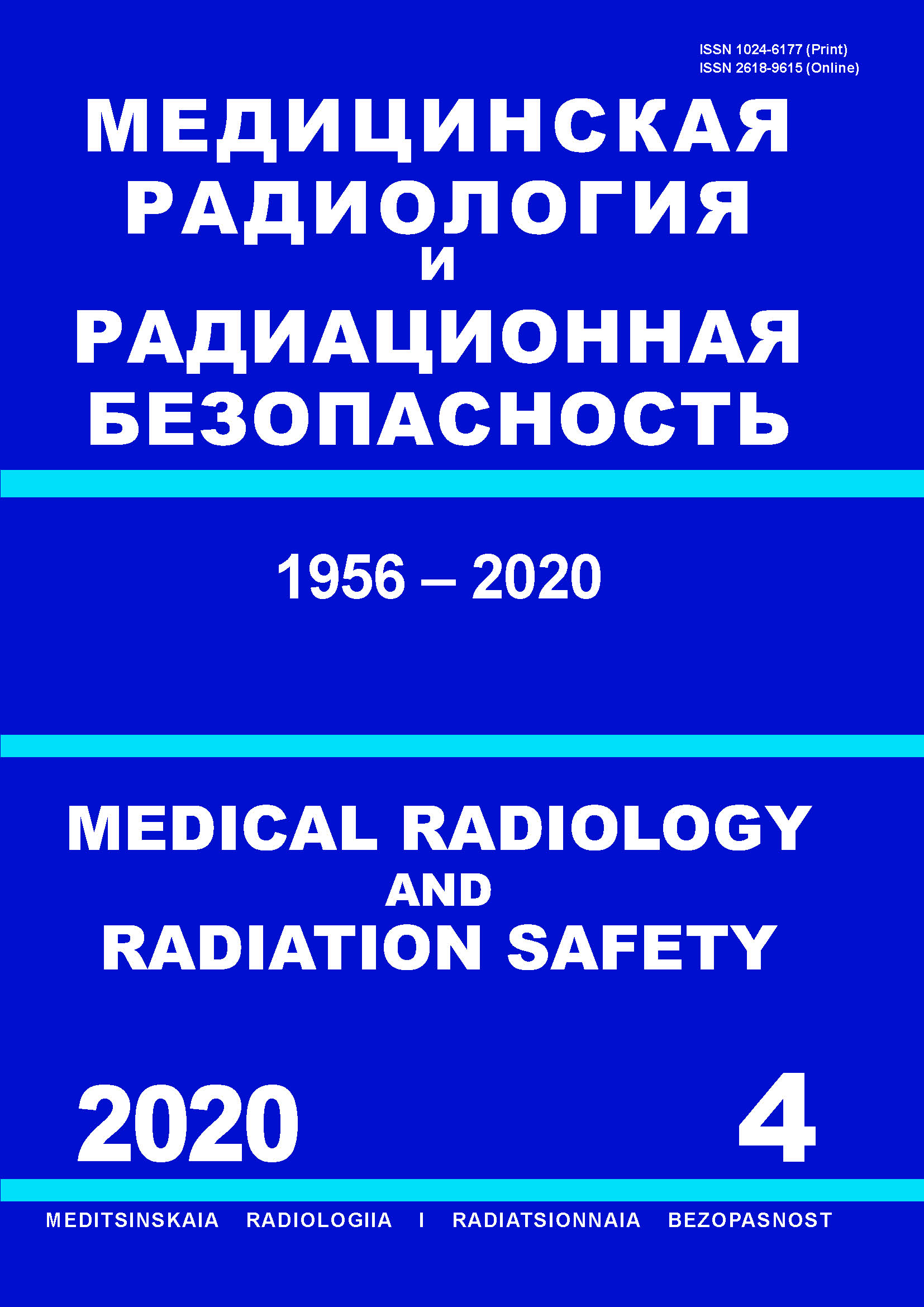VAK Russia 14.02.2004
UDC 61
CSCSTI 76.01
CSCSTI 76.03
CSCSTI 76.29
Russian Classification of Professions by Education 31.08.08
Russian Classification of Professions by Education 31.07.01
Russian Library and Bibliographic Classification 54
Russian Library and Bibliographic Classification 58
Russian Trade and Bibliographic Classification 573
Russian Trade and Bibliographic Classification 5734
BISAC MED080000 Radiology, Radiotherapy & Nuclear Medicine
Purpose: To study late mental and behavioral disorders (ICD-10) in individuals who were accidentally exposed in the Southern Urals. Material and methods: The research subjects are the persons who were exposed to radiation as a result of dumping of radioactive waste into the Techa River (1949–1956), who were born before 1953 and lived in the Techa River basin between 1950 and 1960. The study group consists of 425 people, women predominate (72.5 %), people with secondary special education make up 44.5 %, and pensioners amount to 89.4 %. Mean age at examination was 67.3 ± 5.3 years. Information on radiation doses included data on the absorbed dose to the stomach, which was considered as an analog of brain exposure (50 ± 3 mGy). The paper uses clinical-anamnestic, clinical-psychopathological, clinical and instrumental methods. Results: It has been demonstrated that in the long-term period, accidentally exposed individuals have organic nonpsychotic mental disorders (72.2 %), with the predominance of organic asthenic (29.6 %) and organic cognitive (36.5 %) disorders. Among the studied individuals, only 20.9 % showed no signs of mental illness. Higher absorbed doses to the stomach (70 ± 8 mGy, p = 0.01) was determined in patients with organic cognitive disorder. Concomitant somatic pathology is present in patients with organic cognitive disorder — hypertension (90.3 %, p = 0.005), ischemic heart disease (56.7, p = 0.004), chronic brain ischemia (43.2 %, p = 0.04). Patients with organic asthenic disorder may have hypertension (94.4 %, p = 0.0002), ischemic heart disease (51.6 %, p = 0.04), chronic brain ischemia (35.7 %, p = 0.02). In the group of patients without mental pathology, the most common were hypertension (76.4 %), diseases of the musculoskeletal system (61.7 %, p = 0.03), and ischemic heart disease (37.1 %). Multiple correlation analysis showed a weak statistically significant association of organic mental disorders with chronic brain ischemia, hypertension, ischemic heart disease and the age of patients. Conclusion: The performed study complements the current understanding of long-term mental disorders in exposed individuals, and requires further research to study the pathogenesis of cerebrovascular and cardiovascular diseases in individuals exposed to radiation.
population, chronic radiation exposure, Southern Urals, accidental radiation exposure, mental disorders
1. Rumyantseva GM, Muravyov AI, Levina T.M, Sidoryuk OV. Occurrence of mental disorders in population affected by radiation accident: structure, dynamics, risk factors. Radiation Hygiene. 2013;6(2):21-26 (In Russ.).
2. Chekin SJu, Kashheev VV, Karpenko SV, Lovachjov SS, Shhukina NV, Ivanov VK. Identification of groups at risk for mental and behavioral disorders among Chernobyl clean-up workers residing in the Kaluga oblast. Radiation and Risk. 2017;26(1):23-34. (In Russ.).
3. Ahaladze NG. Hiroshima and Nagasaki, Chernobyl and Fukushima. The influence of late effects of radiation exposure on the ageing speed and human vitality (literature review). Issues of Ageing and Longevity. 2016;25(3):369-79. (In Russ.).
4. Bromet EJ. Mental health consequences of the Chernobyl disaster. J Radiol Prot. 2012;32(1):N71-N75. DOI:https://doi.org/10.1088/0952-4746/32/1/N71.
5. Laidra K, Rahu K, Kalaus KE, et al. Mental disorders among Chernobyl cleanup workers from Estonia: A clinical assessment. Psychol Trauma. 2017;9(Suppl 1):93-97. DOI:https://doi.org/10.1037/tra0000195.
6. Lieber M. Assessing the Mental Health Impact of the 2011 Great Japan Earthquake, Tsunami, and Radiation Disaster on Elementary and Middle School Children in the Fukushima Prefecture of Japan. PLoS One. 2017;12(1):e0170402. DOI:https://doi.org/10.1371/journal.pone.0170402.
7. Oe M, Fujii S, Maeda M, et al. Three-year trend survey of psychological distress, post-traumatic stress, and problem drinking among residents in the evacuation zone after the Fukushima Daiichi Nuclear Power Plant accident [The Fukushima Health Management Survey]. Psychiatry Clin Neurosci. 2016;70(6):245-52. DOI:https://doi.org/10.1111/pcn.12387.
8. Burtovoj MYu. Genesis of international regulation of cooperation of states in the field of energy resources. Bulletin of the South Ural State University. Ser. Law. 2019;19(2):42-7. (In Russ.).
9. Shalaginov SA, Akleev AV, Hall P, Granath F. Incidence of unspecified mental retardation among offspring of parents chronically exposed to radiation. Medical Radiology and radiation Safety. 2002;47(2):26-33.
10. Shalaginov SA. Analysis of radiation, population genetic and general environmental factors in the genesis of various forms of oligophrenia in offspring of chronically exposed population: Extended abstract of Cand. Sci. (Medicine) Dissertation. Moscow. 1998. (In Russ.).
11. Burtovaia EYu, Kantina TE, Litvinchuk EA. Characteristics of late mental (cognitive) impairments in persons exposed to irradiation in the South Urals. Siberian Herald of Psychiatry and Addiction Psychiatry (In Russ.).
12. Akleev AV. Chronic radiation syndrom among residents of the coastal villages of the Techa river. Chelyabinsk. 2012 (In Russ.).
13. Podsonnaya IV, Schuhmacher GI, Golovin VA. Dyscirculatory encephalopathy in Chernobyl NPP clean-up workers (findings of a 20-year follow-up). SS. Korsakov Journal of Neurology and Psychiatry. 2009(2)10-3. (In Russ.).
14. Ivanov VK, Maksyutov MA, Chekin SYu, Kruglova ZG, Petrov AV, Cyb AF. Radio-epidemiological analysis of incidence of non-cancer diseases among Chernobyl liquidators. Radiation and Risk. 2001;(12):82-98. (In Russ.).
15. Stewart FA, Akleev AV, Kiselev M.F. ICRP Publication 118. Early and remote effects in normal tissues and organs - threshold dose for tissue reaction in the context of radiation protection. Chelyabinsk. Publishing House Kniga. 2012 (In Russ.).
16. Preston DL, Shimizu Y, Pierce DA, et al. Studies of mortality of atomic bomb survivors. Report 13: Solid cancer and noncancer disease mortality: 1950-1997. Radiat Res, 2003,160(4):381-407.
17. Krestinina LY, Silkin SS, Degteva MO, Akleyev AV. Risk analysis of the mortality from the diseases of the circulatory system in the Ural cohort of emergency-irradiated population for the years 1950-2015. Radiation Hygiene. 2019;12(1):52-61. (In Russ.).





